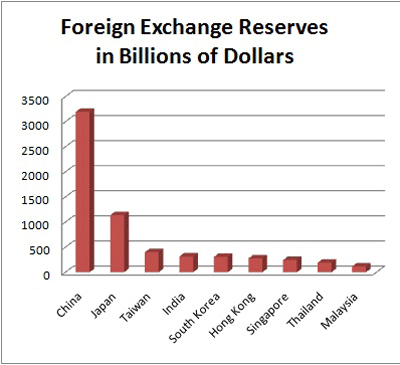




As the U.S. Congress remains deadlocked over raising the government debt limit, Asian economies are fretting over the implications if Washington suffers its first major default on its credit obligations.
The U.S. will run out of money to pay its bills if lawmakers cannot forge a deal to raise the borrowing cap by August 2, triggering financial market turmoil and a jump in interest rates, casting gloom over the world economy.
Even if it avoids a default, credit rating agencies say they may strip the U.S. of its prized triple-A rating, unless Washington emerges with an adequate plan to slash its soaring budget deficit .
Asian economies are on the front line of the U.S debt debacle as they hold the world's largest foreign exchange reserves denominated mostly in U.S. dollars.
They could see their reserve stockpile diluted by a debt default or credit downgrade, which would send the greenback reeling.
"I think that is not a major long-term concern because there is still faith in the U.S. that it will get its act together eventually, but the bigger concern in the short run is whether this uncertainty leads to a spike in U.S. interest rates which would hurt U.S. activity," Eswar Prasad, a former head of the International Monetary Fund (IMF) China division, told RFA.
"The U.S. still remains an important export market for Asia," he said. "So, that could have some spillover effects to Asia."
If the U.S. defaults or faces a credit downgrade, it would be forced to increase interest rates on benchmark Treasury securities, a move that would have a rippling effect throughout the financial markets.
Borrowing costs for mortgages and credit cards would rise, putting a huge drag on the U.S. economy, which is weakening again after recovering from a major financial crisis.
Europe, another key export region for Asia, is also gripped by a serious debt crisis which threatens to spread from Greece to bigger eurozone economies, such as Spain and Italy.
Big impact
Asian nations may find the impact of the debt woes in the two major markets too much to bear, said Prasad, an economics professor at Cornell University.
Asia is already grappling with high inflation fueled by extreme weather conditions and supply constraints that have driven food, oil, and commodity prices higher.
“Growth is easing in most of emerging East Asia as authorities wind down fiscal stimulus measures and tighten monetary policies to counter rising inflation,” said Iwan Azis, the head of the Asian Development Bank's office of regional economic integration.
A report from the Manila-based ADB on Thursday highlighted the risk of rising inflation leading to wage-price spirals that could derail the region’s relatively rapid growth.
Higher consumer prices have forced governments in Asia to hike interest rates and take other measures to cool down their economies, but such moves could boomerang.
"The problem is that they are all fighting inflation, and if they end up cooling off their economies through domestic policy measures at the same time the major economies are weakening, that combination could increase the probability of a hard landing," Prasad warned.
There are also worries that Asia's export-dependent economies may lose their competitiveness as their currencies jump against the U.S. dollar as the West reels from debt turmoil. Higher currencies make exports expensive.
This week, Singapore's currency surged to a new all-time high against the U.S. dollar, the Malaysian ringgit hit a 14-year high, the Indonesian rupiah climbed to a seven-year high, and the Philippine peso reached a three-year high.
The Japanese yen also jumped to its highest level against the greenback since the post World War II-high in March.
Central banks in South Korea, Taiwan, and Thailand have been intervening to curb their currencies' gains, traders said.
Three of Southeast Asia's middle income economies—Malaysia, the Philippines, and Thailand—should see growth taper due to diminished export demand and tighter monetary policy, the ADB said.
Volatility
Any unresolved debt problems in the U.S. and Europe would increase financial market volatility and destabilize capital flows, the bank warned.
A U.S. debt default or credit downgrade will send the Asian currencies even higher against the dollar, experts said.
"We know that investors will react negatively to a downgrade or a default, but the question is how negatively? Will it be a 2, 3, 5, or 10 percent day?," Kathy Lien, director of currency research at GFT Forex in New York, asked in a report Wednesday.
"In our opinion, a downgrade should drive the dollar lower by at least another 2 to 5 percent, while a default could send the dollar tumbling another 5 to 10 percent," she said.
However, even with a downgrade, the U.S. markets will remain liquid, and eventually the U.S. government will find a way to meet all of its debt obligations, restoring confidence in U.S. Treasuries, Lien said.
Fitch, the only rating agency that has not placed the U.S. on review for a downgrade, said U.S. Treasuries would remain the world’s bond benchmark even if other rating agencies strip America of its AAA rating.
It said this is because there are no alternatives among low-risk bonds that could easily replace the size and scope of the U.S. government’s outstanding debt.
"If a downgrade or default drives the dollar sharply lower, there is even a chance of intervention by the G20 to stem the dollar’s slide, Lien said, referring to the Group of 20 emerging and developed economies.
Safe haven
